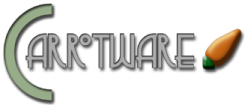Note: that a majority of these templates are for the WebForms version of the CMS, there are some for the MVC version. Each download is labeled for which version it is associated with. If you are unsure, archives containing files with ASPX, ASCX, or MASTER extensions are for webforms, and those with CSHTML are for the MVC version. The MVC ones below are for the MVC 5 version, but with a little tweaking, such as changing "CarrotWeb." to "Html.CarrotWeb()." or "CarrotCakeHtml." to "Html.CarrotCakeHtml()." and changing "@inherits CmsWebViewPage" to "@inject PagePayload CmsPage" they can generally work with the MVC Core version. Once there is a Core section, both templates would be CSHTML, but use of inherits vs inject is an easy way to tell if it is for Core 8 (inject) or for Framework MVC 5 (inherits).
Each of these zips for the WebForms version should be extracted and the files placed directly under a folder within ~/cmsTemplates/ such as ~/cmsTemplates/{{zip_file_name}}/ . If they do not immediately show up in your template list, click the "refresh configs" button in the management dashboard. Also confirm that your files are at the root of the template folder and not in a sub folder. You should see files look something like ~/cmsTemplates/{#zip_file_name#}/Skin.config rather than ~/cmsTemplates/{#zip_file_name#}/{#zip_file_name#}/Skin.config.

The MVC version generally will have two folders represented in an archive, one which will go to ~\Assets\ and the other to ~\Views\Templates\, if there are no directories, extract into a new directory of your choosing within the ~\Views\Templates\ folder. In this image, you can see how the folders pair up. As above, if the template does not appear right away, perform a config refresh. The MVC templates have two folders due partly to special security surrounding the Views folder (you cannot directly serve content from this folder without tampering), and partly because of the separation of concerns in MVC, the Views folder should be limited to the rendering templates, so Assets will contain the "optional" content such as images style sheets, and JavaScript etc. For the simplicity of having a single folder for the whole template, the webforms version has been configured to be all inclusive, however, if you are making your own templates, you can certainly split the files across several folders as the MVC versions have been.

The MVC version of Telephasic supports pulling in the designated site skin color, select the "Themed" version to use. To use the original peach/pink, select the non "Themed" versions. For example, use of Classic will provide a medium green gradient, Mauve, a purple gradient and BlueIzis a periwinkle gradient.




Additional Template Resources
CarrotCake CMS is a free, open-source web CMS built on the Microsoft ASP.NET Framework in both webforms and MVC variants. It is easy to use, simple to understand, and is highly extensible using industry-standard languages and patterns such as HTML, CSS, jQuery, MSSQL, and C#. CarrotCake CMS is powerful and flexible whether you're a web designer or a .Net geek.

We believe that website publishing should be simple. Website owners should be able to drag and drop various content at the website and the websites need to be smart enough to accept and publish everything with the click of a button. It's similar to making a collage, cutting and pasting, stitching and gluing. This should just work. A CMS should have minimal constraints on your design.
With CarrotCake, you will be able to do exactly that. So far we made it possible to add images and links in your pages. You can easily upload an image and add it to the website. And if you want to add a downloadable file, just browse to the file and add a link in any page and CarrotCake will make a link, with the name and the link to the file. Just like that.
